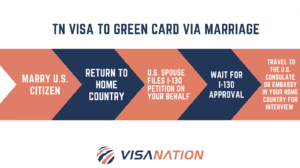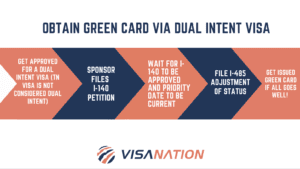TN Visa to Green Card
There are many effective ways to live in work in the U.S. temporarily, one of which being the advantageous TN visa. With no annual cap and a relatively low cost to apply, the TN is the perfect visa for Canadian and Mexican workers. But what if you want to make your stay a permanent one? Keep reading to find out what it takes to go from a TN visa to green card status and how you can make the transition as smoothly as possible.
TN Visa to Green Card: Marriage
The TN visa is meant to be a temporary visa option. To qualify, you will need to demonstrate that you intend to stay in the U.S. for a limited amount of time. For this reason, you must be very careful when pursuing a green card. An action such as marrying a U.S. citizen can cause the USCIS to doubt your intention to leave the country after your TN visa stint is over. This can create difficulties if you intend to renew your TN visa or apply for a marriage-based green card.
You will need to work closely with your attorney to make sure that you avoid jeopardizing your status if you intend to go this route. If your case allows you to obtain a green card by marriage while under TN status, here are the steps:
- You must marry a U.S. citizen.
- You will need to return to your home country.
- Your U.S. spouse will need to file an I-130 petition on behalf of you, their alien relative.
- You will need to wait until the I-130 has been approved (4-6 months).
- Then you can travel to the U.S. consulate or embassy in your home country (Montreal for Canada and Juarez for Mexico) for an interview with a consular officer to determine the validity of your marriage.
- If approved, you will receive your green card.
Alternatively, you might be able to adjust your status while still in the U.S. However, this is very risky and would likely restrict your ability to work and travel until the adjustment of status is complete. Speak with your immigration attorney to determine if this route is suitable for your situation.
Processing Timeline
Overall, the TN visa to green card process can take between six months and a year, sometimes more. Much of it depends on how busy your service center and/or U.S. consulate is. Unfortunately, there is no way to expedite this process.
TN Visa to Green Card: Employment
Once you have a dual intent visa, you can immediately file the petition for your green card. If you are going for an employment-based green card you will need to either file an I-140 petition for alien worker or have an employer file one on your behalf. There are some green cards that allow you to self-petition (such as the EB-1A and the EB-2 with a National Interest Waiver), but most require you to have a sponsoring employer to file for you.
Choosing the right employment-based green card for your TN visa scenario should be based on your qualifications. Having an advanced degree will allow you to get an EB-2 while being a multinational manager or executive could merit you an EB-1C. The difference between these green cards is only the qualifications required and amount of time it takes to get them.
Here are the general steps:
- Your sponsor (either you or your employer) must file an I-140 petition
- You must wait for two things to happen: your I-140 must be approved and your priority date must be current. We’ll cover priority dates later on.
- If both conditions are met, then you can file an I-485 adjustment of status form and wait for its approval.
- Then you will be issued your green card and your nonimmigrant TN status will be adjusted to immigrant status.
Alternatively, if you choose not to get a dual intent visa, you can simply leave the U.S. and apply for a green card from your home country. In that case, once your priority date is current, you will need to make an appointment with the U.S. consulate in either Mexico or Canada and travel there for a one-on-one interview with a consular officer. This process is called consular processing and stands as an alternative to adjustment of status, which is only available to people who are in the U.S. under a nonimmigrant dual intent visa status.
If you are not familiar with priority dates, here is a quick explanation. When you file your green card petition, the date that the USCIS receives it will be marked as your priority date. This date is yours and does not change. The priority date must be compared to another date called the “final action date”. You will find this posted in the monthly visa bulletin released by the Department of State. Final action dates usually change every month and are assigned based on the type of green card and the beneficiary’s country of origin.
If too many people from one country apply for the same green card, the date will go backward, away from your priority date. Otherwise, the date should either remain in the same place or advance forward. Remember to check the visa bulletin every month to see how close the final action date in your category is to your priority date. Once the final action date matches or passes your priority date, you will be able to either adjust your TN status or make an appointment for consular processing.
You cannot speed up the priority date waiting time, but you can expedite your I-140 processing time from the usual six months to just 15 calendar days with the optional service called premium processing, which costs an extra fee. However, this is not available for the EB-1C or the National Interest Waiver.
TN Visa Background
The TN visa is a nonimmigrant work visa designed specifically for the citizens of Mexico and Canada to work temporarily in the U.S. provided that they have a certain occupation. These two countries are joined with the U.S. by the North American Free Trade Agreement (or NAFTA) and the workers that come and go through TN status are referred to as NAFTA professionals. Here are the main requirements for a TN visa:
- You must be a citizen of either Mexico or Canada—lawful permanent residents of these countries are not eligible.
- You must have a job offer from a U.S. employer for full or part-time work. You do not qualify if you are self-employed.
- You must have a part-time or full-time position with a U.S. employer for one of the following positions that require NAFTA professionals. These include: Accountant, Plant Breeder, Poultry Scientist, Soil Scientist, Zoologist, Landscape Architect, Forester, Graphic Designer, Chemist, Dairy Scientist, Entomologist, Epidemiologist, Geneticist, Hotel Manager, Industrial Designer, Interior Designer, Land Surveyor, Lawyer, Management Consultant, Mathematician, Librarian, Urban Planner, Vocational Counselor, Dentist, Dietitian, Medical Laboratory Technologist, Range Manager, Research Assistant, Scientific Technician, Social Worker, Technical Publications Writer, Pharmacist, Physician, Physiotherapist, Psychologist, Recreational Therapist, Registered Nurse, Seminary Professor, University Professor, Veterinarian, Architect, Computer Systems Analyst, Economist, Engineer, Agriculturist, Animal Breeder/Scientist, Agriculturist, Astronomer, Biochemist, Biologist, Geochemist, Geologist, Geophysicist, Horticulturist, Meteorologist, Pharmacologist, Physicist, Nutritionist, Occupational Therapist, College Professor.
The TN is divided into two categories. The TN-1 is for Canadian citizens and the TN-2 is for Mexican citizens. As far as cost is concerned, you are only responsible for the I-129 processing fee of $460, an application fee of $50, and an I-94 arrival/departure card fee of $6, totaling at $516, far less than the average nonimmigrant visa.
Tip: Did you know that Canadian citizens can apply for TN status at a U.S. port of entry? Unlike Mexican citizens who are required to have the TN visa ahead of time, Canadian citizens can apply at the port with the required documentation presented to a U.S. Customs and Border Protection officer.
Dual Intent
If a nonimmigrant visa has dual intent, it simply means that you are able to apply for lawful permanent residence without jeopardizing your nonimmigrant status. Unfortunately, the TN does not have dual intent, which means that you may incur penalties, fees, or even a bar from re-entry if you apply for a green card from TN status. Not to mention the fact that your green card petition will likely be denied.
To get around this rule, you will need to change your TN status to that of a different nonimmigrant visa that has dual intent. Here are some common alternatives:
H-1B
The H-1B is the most popular nonimmigrant work visa available due to its many benefits and its inclusivity. As long as you have a bachelor’s degree and a U.S. job that requires that degree, then you are eligible to receive this six-year visa. It allows the holder to work for any U.S. employer and even allows for holders to work for multiple employers simultaneously. You can also easily transfer H-1B status from one employer to the other.
Learn about the difference between TN visa vs H-1B visa.
However, there is a catch. The H-1B gets so many petitions each year, the USCIS has imposed an annual cap of just 80,000 visas. To determine which petitions go onto processing, the Service holds a lottery in which petitions are randomly selected by a computer. Because so many people petition, the chances of being selected can often be relatively low.
Criteria to be considered a specialty H1B occupation:
- Requires a bachelor’s degree or higher or equivalent at minimum.
- The required degree for the H-1B job is considered typical in the industry.
OR
- The position can only be executed by an individual holding a degree due to its complexity.
- It is usual for the employer to require a degree or equivalent for the position because the skills are so specialized.
Learn more about the H-1B Visa 2022-2023 Cap Season.
Regardless, the H-1B is likely going to be your best bet when it comes to adjusting your status from TN visa to green card.
L-1
The L-1 visa is also a good alternative to the TN, but not a perfect one. It allows multinational companies to send their managers, executives, and specialized employees to their locations in the U.S. There is no annual cap or lottery and there is no education requirement, making it an ideal option in light of the H-1B. Additionally, an employer can file one petition for multiple L-1 visas at the same time, making it cheaper for the employer.
However, the L-1 is an employee transfer visa, meaning that you must be an employee of a multinational company to take advantage of it. You need to have been an employee in the overseas branch for at least one year in the three years preceding your L-1 petition. Here is an example of where it would work if you had a TN visa:
Diana is an architect from Mexico who is working as TN nonimmigrant in the U.S. for her multinational agency that has a branch in Texas. She only started in the Texas branch a year ago, so she can ask her agency to petition for an L-1B visa for employees with specialized knowledge. Technically, it would count as a transfer from the Mexican branch to the U.S. branch and she would then have a dual intent visa.
Frequently Asked Questions
Can you go from TN visa to green card?
While they’re isn’t a direct route from TN visa to green card, you can explore the dual intent options mentioned above or another employment-based path. Consult your immigration attorney to know what you qualify for.
Can my spouse and kids come with me on the TN visa?
Yes, you are allowed to sponsor your spouse and children under the age of 21 for the length of your visa. You cannot sponsor other relatives through this route.
Can my spouse work?
No, they are not eligible to work but they are permitted to study while in the U.S.
Can you do residency on TN visa?
Since it is considered a temporary visa, you are not permitted to use it to work in the U.S. while intending permanent residency. Consequences apply if officials find out you are doing so.
Can I apply for the visa and then decide who my employer will be?
You need to choose the employer before applying for TN visa.
Can you switch from TN visa to H1B?
While there is no direct path, you can apply as long as you have a bachelor’s degree and a U.S. job that requires that degree.
How long is the TN visa valid for?
It is initially good for 3 years and after that it can be extended indefinitely.
Can I take advantage of my spouse’s dual intent visa?
Yes, you can be on their application for a green card as a dependent if they are on dual-intent status and have the option to apply for permanent residency!








